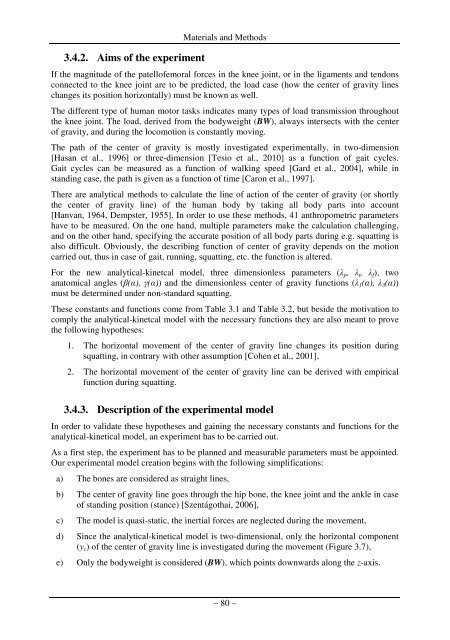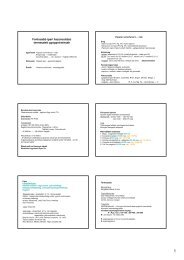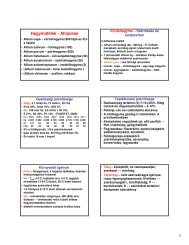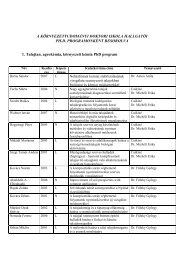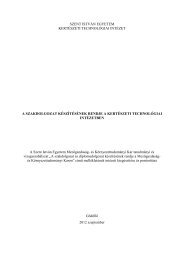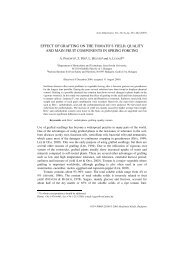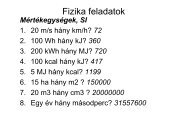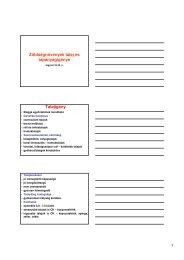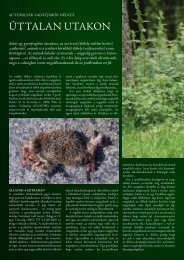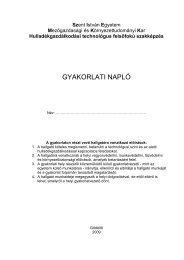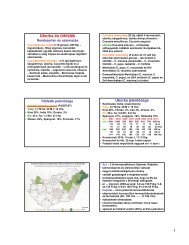PhD Fekete - SZIE version - 2.2 - Szent István Egyetem
PhD Fekete - SZIE version - 2.2 - Szent István Egyetem
PhD Fekete - SZIE version - 2.2 - Szent István Egyetem
Create successful ePaper yourself
Turn your PDF publications into a flip-book with our unique Google optimized e-Paper software.
3.4.2. Aims of the experiment<br />
Materials and Methods<br />
If the magnitude of the patellofemoral forces in the knee joint, or in the ligaments and tendons<br />
connected to the knee joint are to be predicted, the load case (how the center of gravity lines<br />
changes its position horizontally) must be known as well.<br />
The different type of human motor tasks indicates many types of load transmission throughout<br />
the knee joint. The load, derived from the bodyweight (BW), always intersects with the center<br />
of gravity, and during the locomotion is constantly moving.<br />
The path of the center of gravity is mostly investigated experimentally, in two-dimension<br />
[Hasan et al., 1996] or three-dimension [Tesio et al., 2010] as a function of gait cycles.<br />
Gait cycles can be measured as a function of walking speed [Gard et al., 2004], while in<br />
standing case, the path is given as a function of time [Caron et al., 1997].<br />
There are analytical methods to calculate the line of action of the center of gravity (or shortly<br />
the center of gravity line) of the human body by taking all body parts into account<br />
[Hanvan, 1964, Dempster, 1955]. In order to use these methods, 41 anthropometric parameters<br />
have to be measured. On the one hand, multiple parameters make the calculation challenging,<br />
and on the other hand, specifying the accurate position of all body parts during e.g. squatting is<br />
also difficult. Obviously, the describing function of center of gravity depends on the motion<br />
carried out, thus in case of gait, running, squatting, etc. the function is altered.<br />
For the new analytical-kinetcal model, three dimensionless parameters (λ p , λ t , λ f ), two<br />
anatomical angles (β(α), γ(α)) and the dimensionless center of gravity functions (λ 1 (α), λ 3 (α))<br />
must be determined under non-standard squatting.<br />
These constants and functions come from Table 3.1 and Table 3.2, but beside the motivation to<br />
comply the analytical-kinetcal model with the necessary functions they are also meant to prove<br />
the following hypotheses:<br />
1. The horizontal movement of the center of gravity line changes its position during<br />
squatting, in contrary with other assumption [Cohen et al., 2001],<br />
2. The horizontal movement of the center of gravity line can be derived with empirical<br />
function during squatting.<br />
3.4.3. Description of the experimental model<br />
In order to validate these hypotheses and gaining the necessary constants and functions for the<br />
analytical-kinetical model, an experiment has to be carried out.<br />
As a first step, the experiment has to be planned and measurable parameters must be appointed.<br />
Our experimental model creation begins with the following simplifications:<br />
a) The bones are considered as straight lines,<br />
b) The center of gravity line goes through the hip bone, the knee joint and the ankle in case<br />
of standing position (stance) [<strong>Szent</strong>ágothai, 2006],<br />
c) The model is quasi-static, the inertial forces are neglected during the movement,<br />
d) Since the analytical-kinetical model is two-dimensional, only the horizontal component<br />
(y c ) of the center of gravity line is investigated during the movement (Figure 3.7),<br />
e) Only the bodyweight is considered (BW), which points downwards along the z-axis.<br />
– 80 –


